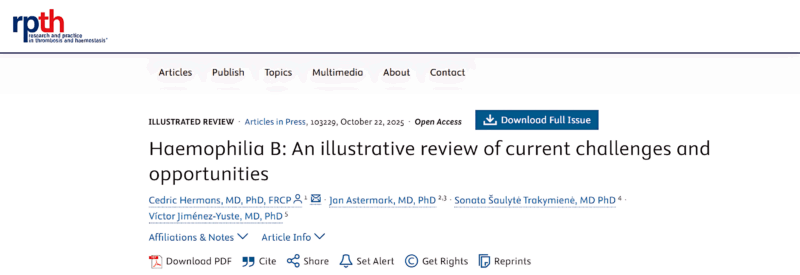
Haemophilia B – An illustrative review of current challenges and opportunities
Wolfgang Miesbach, Professor of Medicine at Frankfurt University Hospital, posted on LinkedIn:
”Excellent illustrated review on haemophilia B just published. Haemophilia B represents only 15% -20 % of haemophilia cases but has distinct challenges.
This compehensive review by Cedric HERMANS MD PhD FRCP (Lon, Edin), Jan Astermark, Sonata Saulyte Trakymiene, and Victor Jiménez-Yuste highlights current insights and clinical advances as well as challenges in haemophilia B care.
The visual content makes it perfect for teaching and patient information:
– Basics – F9 gene (33.5kb, 8 exons), FIX protein (55 kDa), X-linked inheritance
– Clinical picture – bleeding patterns across all severities, quality of life impacts
– Treatment timeline – from 1920s ice packs → plasma → rFIX → EHL products → gene therapy → non-factor therapies
– Tricky situations – inhibitors, surgery protocols, mild/moderate disease
– Pharmacokinetics – why FIX behaves differently (extravascular distribution, collagen IV binding)
– Individualization – matching treatment to patient life, not just labs
– Carriers and research gaps – underserved populations and what we still don’t know
Differences between haemophilia B and haemophilia A:
– Pharmacokinetics: FIX circulates both inside and outside blood vessels
Binds to collagen IV in extravascular tissues (FVIII doesn’t)
Lab tests miss extravascular FIX
– Inhibitors: Lower incidence (1.5-10% vs. 30%) but higher complication rates and ITI only works in 20-30%
– Pregnancy: FIX doesn’t rise like FVIII does – higher bleeding risk for HB carriers during delivery
Gene therapy in haemophilia B:
Haemophilia B was the first target for AAV gene therapy – smaller gene, easier packaging. Recent data show sustained benefit over 10 years
Novel therapies coming:
Anti-TFPI agents & fitusiran (AT siRNA): Subcutaneous options that restore thrombin generation without replacing FIX
No bispecific antibody yet for HB (unlike emicizumab for HA) – but research ongoing
Two neglected populations:
– Mild/moderate HB patients:
May have worse quality of life than severe patients – they bleed unpredictably but rarely get prophylaxis and experience joint damage, hospitalizations, treatment uncertainty.
– Female carriers:
Often undiagnosed or excluded from haemophilia care
FIX doesn’t rise during pregnancy (unlike FVIII)
Only 6% of reported HB population
What we still don’t know:
– Long-term effects of extravascular FIX binding
– Whether cross-reactive material (dysfunctional FIX protein) reduces treatment efficacy
– Optimal dosing for non-factor therapies in HB
– Gene therapy safety beyond 10 years
– How to better diagnose and treat female carriers”
Read the full review here.
Title: Haemophilia B: An illustrative review of current challenges and opportunities
Authors: Cedric Hermans, Jan Astermark, Sonata Šaulytė Trakymienė, Víctor Jiménez-Yuste

Stay updated with Hemostasis Today.
-
Dec 19, 2025, 13:30PPTA Europe’s Holiday Message: Wishing Health, Rest, and Renewal for 2026
-
Dec 19, 2025, 13:22If You Were Reading a “Bible for Blood Donation Volunteers,” What’s the ONE Thing That Must Be in It?
-
Dec 19, 2025, 12:52Julia Owens: Stroke Remains One of the World’s Leading Causes of Death and Disability
-
Dec 19, 2025, 12:03Pradeep Natarajan: Our New Genetic Study of Aortic Stenosis in ~3M
-
Dec 19, 2025, 11:47ESO Blog: Anna Gardin on Stroke Risk in the Era of Climate Extremes
-
Dec 19, 2025, 10:51Sarah Elkourashy Presents Insights on Caplacizumab for TTP at ASH25
-
Dec 19, 2025, 10:08Camilla Lombardi Shares an EHC Nutrition Guide for People with Bleeding Disorders
-
Dec 19, 2025, 09:56Danny Hsu Shares The ”I-WISh” Study by Nichola Cooper on ITP
-
Dec 19, 2025, 09:39Paul Bolaji: A Landmark Achievement -The Historic 1st Nigerian Stroke Leaders’ Summit 2025
